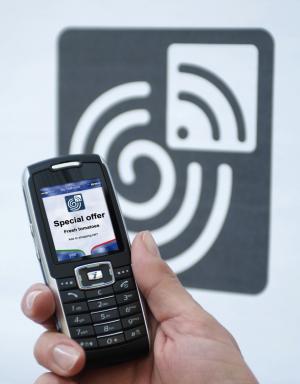NXP Develops NFC Tag-Writing App for Android

NXP Semiconductors, supplier of NFC chips and software for Android smartphones, has developed its own Android app for those phones–enabling users to write content to NFC tags.
The "NXP TagWriter" enables users, as well as merchants and other service providers, to write such content as business card information, URLs for mobile Web sites and SMS messages. They could then be attached to surfaces or embedded in posters, business cards and watches, for example, said NXP today in announcing the app. This could enable users to launch applications automatically to make calls, open Web sites and send text messages, the Netherlands-based chip maker said.
Update: NXP told NFC Times it does not see the app itself as a mainstream consumer application, but one to help developers "integrate NFC into their current and new mobile applications for Android."
"The need for the app was to enable developers to help them create NFC applications," Jeff Miles, director of mobile transactions for NXP, told NFC Times in a statement. "The application was targeted at this group to help them work with NFC tags." End update.
It's not clear why NXP had to develop its own app to encourage third party developers to also develop them. But the fact is, there have not been many Android NFC apps developed since December when Google first introduced Gingerbread. Of course, there is still only one NFC-enabled Android phone on the market, the Nexus S, though more are expected this year.
Still, chip makers do not usually develop their own apps. NXP is no doubt also hoping that by encouraging more app development, it will spur demand for Android NFC phones carrying its chips as well as selling more of its NFC chip tags.
While payment and ticketing applications get most of the attention for expected NFC rollouts, some believe that tag reading, which simplifies the steps to launching apps, sending text messages, making calls and downloading content, will become the most used NFC services and would be easier to roll out. The tag-based apps also could support payment and ticketing.
"One of the best features of NFC is the technology’s ability to read and share information with other NFC users," said Henri Ardevol, NXP’s vice president and general manager for secure transactions, in a statement. Added Steven Fera, NXP strategic account manager: "Simple to use applications, which add value and simplify the user’s life, will be vital to the adoption of NFC."
NXP’s chips are being used in the first Android smartphones to support NFC, including the Nexus S, which is made by Samsung Electronics and launched by Google in December. NXP software also runs on Android phones as part of Google’s latest Android version, Gingerbread.
At present, the Gingerbread NFC application-programming interface only supports tag reading and some peer-to-peer communication, not card emulation for payment and ticketing. But Google, which has big plans for NFC, including enabling payment, is expected to add to the functionality of the operating system. Google recently added tag-writing capability to the NFC API.
NXP also produces NFC tags, based on its proprietary Mifare technology. But the chip maker said today the app "fully supports" the first three NFC Forum standard tag types, of which Mifare is one. It supports the type 4 "tag portfolio."
"I don't find it unusual from NXP," Einar Rosenberg, CTO of U.S.-based NFC application developer Narian Technologies, told NFC Times. "They have an app for their catalog. They have an app to enhance and utilize their own products. Companies today can't simply expect to just put out the product, but also have to lay the groundwork to make it of value to not only their first customer, being the phone maker in this case, but also the final customer, being the consumer."
He noted the somewhat surprising lack of NFC apps so far introduced for Android and said that while Google has been high on NFC, it hasn’t seemed to promote app development yet.
NXP in its press release today suggested tags could be embedded in business cards of the future, enabling “contact details to be shared and stored onto a handset immediately.”
Service providers also could use tags to let users tap to automatically open WiFi connections, provide shortcuts for users to check in with such social network sites as Foursquare, Google Places and Yelp, and get transit timetables and route maps, said NXP.












